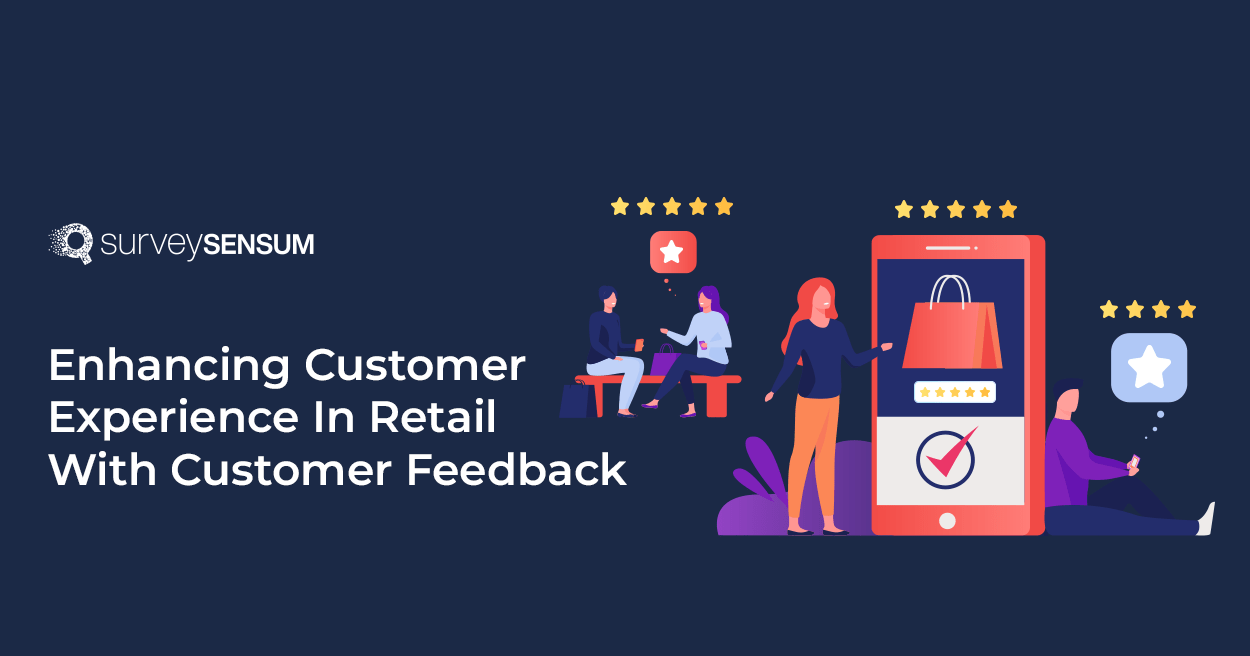Recently, I went to H&M, my favorite brand, to snag a new pair of jeans. After some browsing, I stumbled upon a cool-looking pair, but here’s the kicker: they only had it in size 30, and I needed a size 32. So, I asked a salesperson to help me.
To my dismay, they informed me that they don’t have size 32 in-store. However, they suggested that I scan the product QR code on their online app.
Sounds like a plan, right? Well, not so fast.
The QR scan turned out to be a bust. On the verge of giving up, I decided to manually enter the product code, and voila! It was in stock online. Score!
I promptly added it to my virtual shopping cart and exited the store.
However, I couldn’t help but wonder- What about the faulty QR scan? Does the staff even know about it?
Imagine if the next customer didn’t bother with entering the code manually and left the store feeling disappointed. H&M would literally lose some business.
But how could they know?
Simple, by asking me the right question at the right time.
If the store had sent me a survey through a retail customer feedback platform right after my visit, inquiring about my shopping experience, I would have gladly highlighted the QR scan issue. This way, the store would have been made aware of the problem and could take the necessary steps to fix it.
That is why you must collect customer feedback at all touchpoints across the customer journey. This will help you identify touchpoints with the friction, take the required action, and improve the overall retail experience.
Now, you might be wondering how to achieve this.
To address this, we have put together a comprehensive guide that provides insights into common pain points in both digital and in-store retail experiences, providing actionable strategies to resolve them. And, we explore how leveraging the power of customer feedback can help resolve these issues, ultimately enhancing your customer experience in retail.
Improving Digital Retail Experience-Challenges & Resolutions
Improving the digital retail experience involves tackling challenges faced by retailers. By using customer feedback, retailers can find effective resolutions for these pain points.
Let’s explore how customer feedback can help overcome 4 common challenges faced by them in the digital retail journey.
Painpoint 1: Customer Churn

According to a titled “CallMiner Index” U.S. companies lose $136.8 billion per year due to customers switching companies for reasons that could have been avoided.
Customer churn is bad for any type of business and just like break-ups in real life, it stings. Customer churn affects not only your business growth but also hampers your brand’s reputation.
But the problem here is that brands don’t know WHY customers are leaving them.
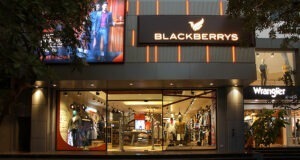
Take Blackberry, an Indian retail brand with over 500 stores, for example. They were significantly losing out on the customers and they didn’t know what to do.
So, what did they do?
They implemented surveys through SurveySensum, gathering valuable feedback on transactions and delivery. Analyzing this feedback using powerful text analytics, they discovered important insights.
The observation?
Customers were switching to other fashion brands due to limited stock availability. Moreover, the absence of a “Try and Return” policy discouraged repeat purchases.
The impact was impressive. Within just six months, Blackberry increased its number of repeat customers by 12-13%.
Are you encountering similar challenges?
Are your customers leaving you too?
Before we dive into addressing customer churn, it’s essential to identify which category of churn you belong to.
Let’s start by understanding the four common types of customer churn in retail and discover effective solutions for each of them. By doing so, you can proactively work towards reducing churn and improving customer retention.
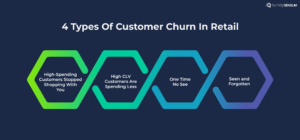
#Churn 1: High-Spending Customers Stopped Shopping With You
When customers who used to spend a lot of money at your company suddenly stop shopping, it’s called high-spending customer churn.
For example, if you used to buy most of your clothes from Amazon but switched to Myntra because they had better options and deals.
So, how can you fix this problem?
Here’s a simple step-by-step process:
STEP 1: Choose the right sample
Talk to the high-spending customers who have stopped shopping to find out why. You can ask them for feedback through surveys or feedback forms.
→ Questions to ask here:
- How frequently did you shop with us before you stopped shopping altogether?
- What were the main reasons or factors that influenced your decision to stop shopping with us?
STEP 2: Identify common issues
Look closely at the feedback you receive and identify common issues or themes.
The issues could be – declining product or service quality, lack of innovation or outdated offerings, unfavorable customer service experiences, or uncompetitive pricing compared to alternatives.
STEP 3: Take action
Take action to address these concerns. For example, if customers have problems with product quality, work on improving it.
STEP 4: Inform customers
Let the customers know about the improvements you’ve made. Communicate with them directly and show that you value their feedback.
By following these steps, you can rebuild the trust and loyalty of high-spending customers. This will help prevent revenue loss and drive the growth of your business.
#Churn 2: High CLV Customers Are Spending Less

This type of churn occurs when customers with a high CLV (Customer Lifetime Value) start reducing their spending over time.
For example, you switched to Zomata from Swiggy because you encountered better deals and discounts and now you order from Swiggy when there is a specific offer of discount.
Here’s what you can do to resolve this issue.
STEP 1: Choose the right sample
Request customer feedback from high CLV customers who are spending less to understand the reasons behind their reduced spending.
→ Questions to ask here:
- Did you encounter any issues that prompted you to leave? Yes/No
- What improvements or changes would encourage you to return to our brand? (Open-ended)
STEP 2: Identify the issues
Analyze the feedback to identify the factors contributing to their decreased spending. The issues could be – declining product or service quality, lack of personalized offers or incentives, diminished customer service experiences, increased competition offering better value, or changes in their own financial circumstances impacting spending habits.
STEP 3: Resolve those issues
Use this feedback to make adjustments to your product assortment, pricing strategies, or loyalty program to meet their evolving preferences and expectations.
STEP 4: Inform the customers
Communicate the changes and improvements to customers to regain their trust and encourage increased spending.
Analyzing customer behavior and adapting your approach accordingly can help re-engage high CLV customers and encourage them to increase their spending with your brand once again.
#Churn 3: One Time No See

This type of churn involves customers who make a single purchase and then fail to return for future transactions.
For example, you bought a pair of sunglasses from an eyewear brand but never visited the website again.
This type of churn represents lost opportunity – the customer tried your brand but never came back because you never interacted with them.
Here’s how to fix that.
STEP 1: Choose the right sample
Gather feedback from the customers who purchased from you only once via post-purchase surveys or follow-up emails, to understand the reasons they may have for not returning.
→ Questions to ask here
- How was your shopping experience with our brand?
- Do you think you will be interested in buying more of our product? If no, please elaborate.
STEP 2: Identify improvement areas
Analyze the feedback you receive to identify potential areas where you can make improvements.
Potential problems could include dissatisfying initial experience, lack of perceived value in the product or service, ineffective communication or follow-up, inconvenient or unfavorable return policy, or discovering better alternatives elsewhere.
STEP 3: Optimize customer journey
Use the feedback to optimize the customer journey and provide better guidance.
STEP 4: Reconnect with customers
Reconnect with these customers by personalizing your communications. Show them that you value their feedback and that you have made changes based on their input.
By following these steps, you can improve the chances of customers returning after their first purchase. It’s important to listen to their feedback, make necessary improvements, and provide personalized incentives to encourage their loyalty.
#Churn 4: Seen and Forgotten

This type of churn refers to customers who show interest by visiting the company’s website or app but fail to convert into paying customers.
For example, you downloaded a beauty brand’s mobile app and explored its features once, but never opened the app again or made any transactions within it.
Now this is a lost revenue opportunity for any brand. The customer interacted with your brand and explored the features but revisited or made any purchase. And the reason might be technical issues, poor website navigation, or just simply forgot about it.
But how to resolve this issue?
STEP 1: Choose the right sample
Gather feedback from the customers who visited but didn’t make a purchase to understand what were they expecting. You can do this through website exit surveys or follow-up emails.
→ Question to ask
- What was the primary reason for abandoning the shopping process? (Open-ended)
- Were there any specific obstacles that prevented you from completing your purchase?
STEP 2: Identify potential barriers
Analyze the feedback you receive to identify potential barriers or pain points that prevented conversion.
The potential barriers could be unclear or unattractive product displays, high prices or perceived lack of value, inadequate product selection, inconvenient store layout or location, unsatisfactory customer service, long wait times, or difficulty in finding desired products.
STEP 3: Address those barriers
Use the feedback to enhance the user experience and address the identified barriers.
STEP 4: Retarget those customers
Implement personalized retargeting campaigns to bring these customers back and encourage them to convert.
By following these steps, you can work towards converting visitors into paying customers. By gathering feedback, making necessary improvements, and leveraging personalized retargeting campaigns, you can enhance the user experience and increase the chances of conversion.
Prevent Customer Churn with SurveySensum
Painpoint 2: Category Growth

It’s not uncommon to experience slow or stagnant growth in certain product categories. This can be frustrating, especially if you’re not sure what’s causing the issue or how to address it.
Several factors can contribute to this issue:
- it could be due to a lack of customer awareness
- lack of customer interest in the category
- ineffective marketing strategies
- limited product assortment
- intense competition from other brands.
Dave and His Sporting Goods Store
Dave runs an awesome online store for sporting goods. He has everything – from outdoor gear to athletic apparel and fitness equipment.
But here’s the thing: he noticed that the sales and growth in the fitness category have been a bit sluggish lately.
So, he decided to do a Product Discovery Survey to get to the bottom of it. And guess what? Turns out, his customers aren’t fully aware of the fitness equipment category because most of the marketing efforts were focused on outdoor gear and athletic apparel! No wonder the fitness category was feeling left out!
But hey, at least he found the friction point and now he can take action to fix it. Time to give that fitness equipment the spotlight it deserves!
Now that you understand this problem area in the digital retail experience. Let’s solve it!
- Increase customer awareness about the category and its benefits through targeted marketing campaigns, educational content, and storytelling.
- Understand customers’ preferences by gathering customer feedback and identifying ways to generate interest in the category.
- Evaluate and refine marketing strategies to effectively reach the target audience. Utilize various channels such as digital advertising, social media, etc to raise visibility and engage potential customers.
- Analyze the competitive landscape and identify strategies to differentiate your brand within the category.
- Regularly monitor performance metrics, sales data, and customer feedback to assess the effectiveness of implemented strategies.
With SurveySensum you can:
- Create NPS, CSAT, and CES surveys in a matter of minutes.
- Collect omnichannel feedback in real-time
- Identify touchpoints with the most friction with journey-based dashboards
- Identify top trends and sentiments from thousands of feedback text analyses in just a few minutes.
- Get instant detractor alerts on your CRM so you can close the loop in time.
Painpoint 3: Addressing Cart Abandonment
Have you ever experienced the frustration of cart abandonment in your industry?
It’s a real pain, isn’t it?
According to a report by the Baymard Institute on ‘Cart Abandonment Stats 2023’, it was found that the average cart abandonment rate is 69.9%.
This statistic is a reality that reflects the importance of evaluating and understanding your cart abandonment rate in order to improve customer experience in retail. This is an important issue to resolve because it represents missed opportunities for conversion and potential revenue.
But how to do that?
- Simplify and optimize the checkout process to minimize friction and make it as effortless as possible for customers to complete their purchases hassle-free.
- Clearly communicate product prices, discounts, and any additional fees upfront. Surprise costs during the checkout process can lead to cart abandonment.
- Set up automated emails or notifications to remind customers of their abandoned carts. Include personalized messages, product recommendations, and exclusive offers to entice them to return and complete their purchase.
- Ensure your website is well-optimized which means that it loads quickly and is mobile-responsive. Slow-loading pages or a poor mobile experience can frustrate customers and lead to cart abandonment.
- Offer real-time assistance through live chat support to help customers with any questions or concerns they may have during the checkout process.
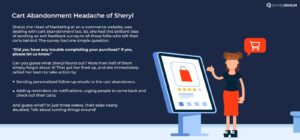
Painpoint 4: Brand Reputation
According to the ‘Local Consumer Review Survey 2023’ by BrightLocal, 84% of people trust online reviews as much as personal recommendations.
That’s why your online reputation matters now more than ever as it impacts your reputation, customers’ trust, and ultimately, your bottom line.
For instance, let me tell you about Patagonia, the outdoor clothing and gear brand. They’re like the champions of brand reputation management! See, they’ve made a name for themselves by being all about the environment and ethical practices.
They don’t just talk the talk – they walk the walk!
Patagonia goes all out to spread its message through different channels, and they even get involved in cool initiatives that help the environment. Plus, they’re super open about where their products come from. All this stuff they do? It’s made them known for being genuine, socially responsible, and for making top-notch gear. They’ve got that reputation game on lock!
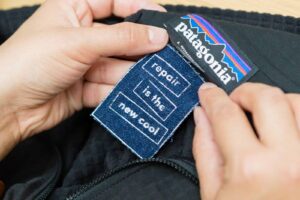
By effectively leveraging customer feedback you can manage and mitigate the negative impact to ensure your business thrives.
Now how can you do that?
By proactively monitoring and managing your online reputation.
- Gather real-time feedback to identify and address issues before they escalate into negative reviews.
- Monitor and respond to online reviews in real-time, turning unhappy customers into loyal advocates for your brand.
- Leverage insights to improve your products, services, and overall customer experience.
- Make it easy for customers to share their experiences and address any issues directly with you, rather than venting frustrations publicly.
- Engage with customers proactively and positively across social media and other online platforms.
Improve Digital Retail Customer Experience!
Improving In-Store Retail Customer Experience

We talked about the importance of improving digital retail experiences for your customers but is that enough?
What about your physical stores?
According to the ‘State of the In-Store Experience 2021’ by Radiyant, it was found that 47% of the respondents estimated that they have spent 51% of their shopping budget in physical stores. While 48% of these respondents stated that they prefer to shop in person in physical stores.
48% is almost half of your customers. You can’t let them go, right?!
Along with customer churn, there are multiple pain points of the brick-and-mortar retailers that they face frequently.
Let’s address those and resolve them one by one.
Painpoint 1: In-store Customer Churn

Lifestyle, a prominent clothing brand in India, faced customer churn, prompting SurveySensum to collaborate closely and develop a tailored solution to address specific issues faced by customers.
Strategy: Our strategy involved reaching out to high-value churned customers via WhatsApp surveys to determine their reasons for leaving. We followed up with one-on-one telephonic interviews to gather contextual details once broad reasons were identified.
Solution: To resolve the challenges, we:
Identified key issues in each store and devised an action plan to address them.
Enhanced online presence, ensuring customers were aware of Lifestyle’s online stores.
Implemented continuous promotions for categories experiencing slow growth.
Results: The result was a noticeable increase in the retention rate within just 6 months.
If your business is also grappling with customer churn and you’re eager to find effective solutions, continue reading for valuable insights.
Losing customers is equal to losing money and no retailer wants that!!
Customer churn can happen for various reasons, such as changing preferences, competition from other stores, dissatisfaction with the shopping experience, or relocation.
So, if you are losing previously engaged customers then it is high to look for the reasons and resolve them.
But how to do that?
Simple. By asking customers about the challenges they are facing while shopping from you. Because if you don’t know what made your customers leave in the first place, how can you solve it? Right?
So start listening to the voice of the customers.
- Actively collect customer feedback: Your customer goes through different interactions at your store during their shopping journey. Engage with them on these touchpoints with well-designed surveys.
- Analyze your customer feedback: Prioritize and address customer concerns and suggestions based on survey feedback. Tools like Text Analytics can do this in minutes and will give you top trends and sentiments from thousands of customer feedback.
- Close the feedback loop: Now that you have collected feedback and analyzed the top concerns, share them with the relevant stakeholders to take prompt action. For example, if you received feedback on bad website navigation, share it with the tech team.
Painpoint 2: High CLV Customers are Spending Less

SPAR India, a leading online grocery shopping and delivery service with physical stores throughout India, faced a significant challenge: their high CLV customers were spending less at one of their physical stores. Upon gathering feedback, they identified the pain point – customers were dissatisfied with the store’s location. Situated near a busy bus stop, the area was characterized by noise and unhygienic conditions, resulting in decreased spending by customers. To address this issue, SPAR India took decisive action by making beautification changes to the store’s location and redesigning its entrance to create a more appealing environment for their valued customers.
Customer churn is not the only issue faced by retail stores. Sometimes your high CLV customers start spending less. This shift can significantly impact your bottom line.
When a high CLV customer starts spending less it directly affects your revenue because they contribute to a significant portion of your revenue. Their decreased spending directly affects the brand’s financial profitability and might also hamper the brand’s reputation.
Failing to understand this will lead to a further decline in customer satisfaction, negative word-of-mouth, and potential churn.
So, how to avoid that?
- By actively seeking feedback through surveys, reviews, or direct communication. You can gain a better understanding of any challenges or concerns that high CLV customers may be facing that you may be aware of. This feedback can highlight specific pain points or areas where the business may be falling short, allowing for targeted improvements.
- But collecting feedback is not enough, you also need to take prompt action to resolve your customer’s concerns. Taking quick actions based on feedback and communicating these changes to your customers will also allow you to regain their trust. This can lead to a resurgence in spending and a restoration of the customer’s value and loyalty.
Painpoint 3: Why is That One Store Not Working?

Reliance Digital is a well-known name in the electronics industry. It has physical stores spread across India. Now, do you think all their stores perform the same?
No.
Some perform better than others even if they are all located in the same state.
And why is that?
Because each store differs from the other in terms of location, staff behavior, store layout, visual merchandising, deals and discounts, and many other aspects.
Does that mean it’s natural? No, and it is 100% fixable by collecting customer and staff feedback.
But how?
To identify the reasons why a particular retail store is not working effectively, you can follow a structured approach:
1. Evaluate store performance
Begin by listing out the top five best-performing and worst-performing stores within your retail chain. Analyze each store to understand what is working well in the successful ones and what is lacking in the underperforming ones.
This analysis will provide insights into the key factors contributing to store success.
2. Gather customer feedback
Engage with customers at the well-performing stores through face-to-face discussions or online surveys.
Seek detailed feedback about their shopping experience, focusing on aspects such as product availability, store ambiance, staff behavior, discounts/offers, ease of navigation, and location convenience. Identify the specific elements that are working positively and yielding good results.
Implement these successful strategies in the store that is not performing well.
3. Assess employee feedback
Gauge the satisfaction and feedback of employees at the high-performing store. Conduct pulse surveys to understand their experiences, key performance indicators, communication channels, teamwork dynamics, and work-life balance. Gain insights into the factors that contribute to employee satisfaction and motivation.
Identify any gaps in these areas at the underperforming store and make necessary improvements.
4. Study competitor analysis
Expand your perspective by collecting feedback from customers who frequent your competitors’ stores. Understand the aspects that customers appreciate about your competitors, such as pricing, product quality, staff expertise, or overall experience.
Identify areas where your store lags behind and take steps to address these shortcomings.
5. Iterate and implement improvements
Once you have identified the successful strategies from customer and employee feedback, incorporate them into the store that is not performing well.
This could involve
- training the staff to adopt a more empathetic attitude,
- ensuring adequate stock availability,
- enhancing customer service,
- improving store layout and navigation,
- offering better discounts, or
- reevaluating the store’s location.
Regularly monitor the store’s performance and make iterative improvements based on customer and employee feedback.
By following this structured approach and implementing the best practices from successful stores, you can work towards improving the performance of the retail store in question.
Painpoint 4: Inventory Management

No one likes to hear “out of stock” when they are shopping at their favorite store. But most retail problems revolve around inventory. Resolving these problems involves the adoption of an efficient inventory management software.
A McKinsey article titled, ‘Risk and resilience in consumer-goods supply chains’, reports that 32% of businesses blamed their supply chain problems on poor inventory management.
If you have poor inventory management, your retail business is likely to suffer without any strategic action to resolve these issues.
Why is that?
- Poor inventory management will result in frequent stockouts.
- It can also result in overstocking, which increases storage costs and can lead to wastage.
- Poor inventory management affects the overall customer experience.
But how to resolve this issue?
- Gather customer feedback to understand product demand: Customers tell you exactly what they need and want. By actively seeking feedback through surveys, you can better understand which products customers desire and ensure that inventory aligns with customer preferences.
- Gather feedback on product performance: By monitoring customer feedback regarding product defects, returns, or complaints, you can identify underperforming items that may require adjustments or removal from the inventory.
- Gather feedback on stock availability: By actively monitoring feedback related to stockouts in online and in-store inventory, you can address issues promptly in real-time.
Painpoint 5: Untrained Sales Team – Customer Service

According to the ‘State of the In-Store Experience 2021’ by Radiyant, 31.5% of the respondents stated that the quality of customer service is the most important for them when it comes to shopping in-store.
Ensuring that your customer service staff is well-trained and knowledgeable about your products is essential as they are the initial point of contact for every customer entering your store.
If they are not well-trained then it will affect your brand’s reputation because it goes without saying that customer service is the cornerstone in ensuring a great in-store shopping experience. If a customer experiences inadequate or bad customer service in your store they are most likely to never come back to your store.
But how to ensure that? Simple, by asking your customers.
- Offer multiple channels for customers to provide feedback, such as surveys, online forms, suggestion boxes, social media, or direct conversations. Make it easy for customers to share their experiences and opinions.
For example, Walmart has strategically placed customer feedback kiosks in their stores. This allows customers to provide real-time feedback on their in-store experience.
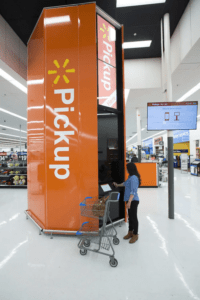
- Try to take immediate action to address any urgent or critical customer concerns raised in the feedback. Promptly respond to complaints, inquiries, or negative experiences, demonstrating your commitment to resolving issues and providing excellent customer service.
For example, this Spotify user faced some issues regarding her Spotify account and the team replied back to her with an immediate solution within 26 minutes.
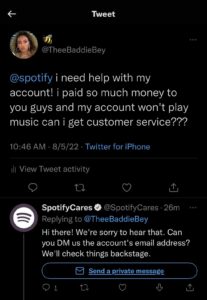
- Keep customers informed about improvements made based on their feedback. Share updates, changes, and initiatives through multiple channels to demonstrate your commitment to their satisfaction. This reinforces a customer-centric approach and builds trust.
So this concludes all the pain points that retailers face for both online and offline stores and their resolutions.
Launch Customer Experience Survey!
Now let’s dive into some best practices to create a great customer experience in retail.
Best Practices to Create a Great Customer Experience in Retail
Let’s understand these 7 best practices, along with some retail customer experience examples, to create a great customer experience for your retail brand.
1.Understanding Your Customers
Understanding the customer is crucial for delivering an exceptional retail experience because it allows retailers to tailor their products, services, and interactions to meet the specific needs and preferences of their customers.
By gaining insights into customer behavior, preferences, and pain points, retailers can create personalized experiences, anticipate customer needs, and provide solutions that exceed their expectations.
According to a study conducted by Salesforce, 76% of customers expect companies to understand their needs and expectations.
Brand Example: A well-known example of a company that excels in understanding its customers and delivering exceptional retail experiences is Amazon. Through their extensive use of data analytics and customer insights, Amazon has been able to personalize recommendations, streamline the shopping process, and create a seamless end-to-end customer experience.
For instance, when a customer visits the Amazon website, they are greeted with personalized product recommendations based on their browsing history and previous purchases. Amazon’s recommendation engine uses algorithms to analyze vast amounts of customer data to identify patterns and preferences, allowing them to suggest relevant products that the customer is likely to be interested in.
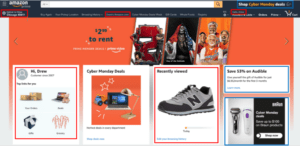
2.Keeping Up With the Changing Customer Expectations
Do you remember the keypad phones by Nokia? And how popular were they in the 90s? But are they relevant in this day and age? No.
Because they were fast replaced by touchscreen phones and smartphones and Nokia was not able to anticipate this demand and was fast replaced by brands like Apple and Samsung.
Don’t let this be your story.
According to the Salesforce research report, ‘State of the Connected Customer’, 63% of customers expect businesses to understand their unique needs and expectations.
So how to anticipate your customer expectations like a pro?
- Actively seek customer feedback at different touchpoints along the customer journey to understand your customer expectations, demands, and changing shopping behavior.
- Use multiple channels for communication like online surveys, social media polls, email feedback forms, etc.
- Consider using feedback management tools or software like SurveySensum to gather customer feedback in real-time and to help you identify emerging complaints, track customer sentiment from thousands of feedback, and act in real-time.
- Based on the insights gained from customer feedback, develop an action plan to address the key areas of improvement.
3.Customers Expect a Seamless Experience – Transition From Online and In-Store
According to Accenture’s ‘Seamless Retail Study’, 49% believe that the most effective way for retailers to enhance the shopping experience is by improving the integration of in-store, online, and mobile shopping channels. And 89% of consumers said that it is important that brands allow them to shop in their most convenient manner, regardless of the sales channel they choose.
When transitioning between online and in-store experiences, customers not only want the same products to be available, but they also want their experience to be seamless. For them shopping is shopping, no matter the medium.
Tips that can help:
- Leverage customer data to build a transparent and seamless cross-channel shopping experience for your customers
- Track customer feedback in real-time
- Allow customers to interact with your brand where, when, and how they want.
For instance, Amazon Fresh Store features the Amazon Dash Cart Lane. You simply take the cart and put your items into it. The cart has a scanner that will scan your items and add them to your Amazon account. Once done, just pack everything and exit the store and the bill will be added to your Amazon account. Completely cashless and hassle-free shopping experience.
This innovation allowed the brand to create the right balance and a transparent seamless shopping experience for their customer between their online account and offline stores. This also customers to shop with Amazon Fresh in their most convenient manner.
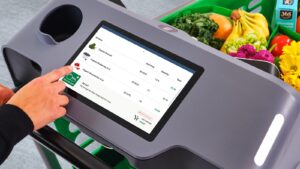
4.Consumers are Choosing Multichannel Buying Experiences
Customer shopping habits have undergone unprecedented transformations due to the influence of digital channels.
According to the Salesforce article, ‘Stats About the Retail Customer Journey’, 87% of the shoppers begin their shopping journey with an online search before visiting any retail outlets.
Creating a seamless multichannel buying experience is not only recommended but also advised as a part of creating a great retail experience.
We saw from the above Amazon Fresh example how Amazon not only created a seamless shopping experience between their online and offline stores but also used multiple channels to deliver that experience. This allowed customers to choose the channel most convenient for them.
So how to implement the same retail customer experience strategy into your business?
Start by creating a buyer persona for your customers. This will allow you to understand and empathize with your target audience. You will gain insights into their specific needs, preference, and shopping behaviors.
This will also help you understand which channels your customer like to shop and optimize your shopping experience. Do they like online shopping via mobile apps or a mixture of both?
For example, Nike offers a click-and-collect service that allows customers to order products online and pick them up at a nearby store. This feature combines the convenience of online shopping with the immediacy of in-store fulfillment.
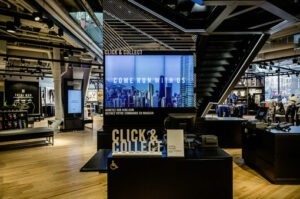
5.Motivate Your Customers To Stay Longer With Membership Program
Many popular brands like Amazon, The North Face, Starbucks, etc offer their customers membership programs with exclusive discounts, early access to new products, free shipping, and exclusive perks reserved for members.
These programs are a great way to retain customers and enhance their shopping experience with you. But does implementing membership programs enough to create a great retail experience? No.
In a survey conducted by Statista among US consumers it was found that in 2022, consumers belonged to 16.6 membership programs on average but actively used a little less than half of those.
But why is that?
- Unclear program policies: Brands fail to communicate their membership policies and the benefits of their programs. For example, you bought a membership to Westside a couple of months ago. When you went shopping there again you were notified that your membership is canceled because you didn’t shop there in the past 6 months, which is something you were not made aware of while purchasing the program.
- Overcomplicated programs: Suppose you decided to buy an online subscription for milk delivery but the brand you chose had a very complicated process of signing up. So you naturally move on from the brand.
- Forgetting to listen to their customers: No one and nothing is perfect but it can be made perfect with perfect tools. Brands implement membership programs but forget to gather customer feedback on their programs which hinders them from making necessary adjustments.
6.Adapt and Improve
In the dynamic world of retail, adaptation, and continuous improvement are key to creating a great customer experience.
Stagnation can lead to a loss of relevance and competitiveness. By embracing change and constantly seeking ways to enhance your retail operations, you can stay ahead of the curve and provide an engaging and memorable experience for your customers.
Here’s how you can do that:
- Stay informed about trends: Continuously monitor market trends, industry insights, and customer preferences to understand the changing landscape of retail.
- Embrace innovation: Be open to incorporating innovative solutions, technologies, and strategies that align with customer demands. For example, adopting e-commerce platforms, or leveraging artificial intelligence to personalize customer experiences.
- Flexible business strategies: Develop adaptable business strategies that can be modified to respond to changing market conditions.
- Customer-centric approach: Prioritize customer satisfaction and listen to their feedback. Actively seek customer opinions through surveys, social media interactions, and customer service interactions to identify pain points, areas for improvement, and emerging needs.
- Collect and analyze customer feedback: Actively seek feedback, pay attention to suggestions and complaints, and develop actionable plans for improvement to build trust and loyalty.
- Train and empower staff: Provide comprehensive training, foster a customer-centric mindset, and encourage ongoing professional development for exceptional customer service.
- Personalize the shopping experience: Utilize customer data, AI, and machine learning to offer personalized recommendations, promotions, and tailored experiences.
- Experiment and iterate: Try new strategies, conduct small-scale projects or A/B testing, monitor results, and refine approaches for continuous improvement.
- Collaborate with partners and suppliers: Build strong relationships, identify growth opportunities, and share insights to enhance the end-to-end customer journey.
Improve Retail Customer Experience with SurveySensum
Retail Customer Experience Trends in 2023
Technologies are evolving, and so is the way retailers engage with their customers. Following are some of the key retail customer experience trends to look for in 2023.
1.Automation and Self-Service to Ease Staffing Shortages
Maintaining high-quality service even with a smaller workforce is a growing trend in retail. Retailers can automate contact centers and warehouses, enabling quicker and more efficient service.
Moreover, retailers with complex products/services can offer self-service kiosks. This allows customers to access information, compare options, and make purchases independently. In doing so, customers can make an informed decision without needing a sales assistant.
Also, these techs can offer your customers convenience, speed, and round-the-clock services. Thus it improves the overall customer experience.
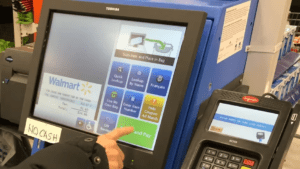
In 2021, the global market value of self-service systems was over 4 billion USD, and it is expected to hit 13-14 billion USD by 2030.
2.Phygital Experiences
This combines the physical and digital worlds to create a unique interactive experience for customers. Phygital experience is yet another growing trend that is going to reign in 2023 and expand in the coming years.
For example, retailers can add technologies into their fitting rooms to allow customers to ask for different sizes and colors digitally. Customers can even adjust the lighting to see how the outfit will look in different environments. These are called smart fitting rooms.
Use similar image

An interesting stat from Statista forecasts the global market of such virtual fitting rooms would climb up to 15 billion USD by 2029. All the more reason for you to consider improving retail customer experience.
3.Immersive Experiences
This essentially uses AR, VR, and MR to create an interactive and personalized shopping experience for customers.
By leveraging these technologies, retailers allow customers to engage with the products in entirely new ways. These experiences can be both in-store or digital, contributing to the concept of phygital experience.
An example is Lenskart. They use AR to allow their customers to try on new frames through their app and select the one that best suits them.
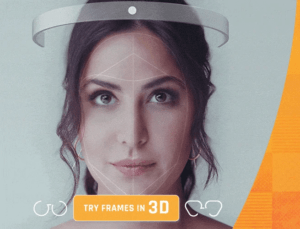
4.Conscious Customer Experience [Sustainability]
Customers nowadays are making their purchase decisions based on ethical and environmental considerations. And this is a growing trend retailers can’t ignore.
According to a study by McKinsey, 60%-70% of the respondents said that they would pay more for sustainable packaging. Another study by Nieselen on sustainability showed that 30% of customers would be more likely to purchase products with sustainable credentials.
There are countless crises affecting our world, and almost everyone is searching for ways to control them. So what can you do? Trying to limit or completely ban the use of plastics would be a start. Recycle the things you can or promote the products that are created using recycled things.
Following is an example of Myntra promoting its clothes.

The Future of Customer Experience in Retail
There is no question that the future of customer experience in retail is intertwined with technology and personalization. Even now, that transition is happening around the world.
As discussed in the previous section, AR has already been implemented by retailers like Lenskart. Shops are increasingly looking into the phygital retail model, which could reshape how customers interact with brands. Not to mention the AI and analytics technologies retailers use to personalize the shopping experience.
As technology evolves, we could see new ways of personalization in retail. But despite these advancements, at the center of the retail business is customer experience. Here, customer feedback matters, and surveys are the best way to collect them.
SurveySensum enables retailers like you to gather, analyze and act upon customer feedback. This helps you better understand your customers and allows you to make informed decisions in improving the CX.
So, are you ready to shape the future of your customers’ retail experience? Try out SurveySenum now and start your journey to exceptional customer experience.







